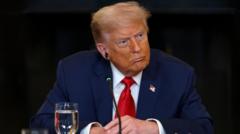President Trump has announced that a significant 35% tariff on Canadian imports will be established starting August 1, further complicating ongoing trade negotiations between the two nations. The letter, posted on Trump's Truth Social platform, suggests additional tariffs of either 15% or 20% on various trading partners. This comes amidst a looming deadline for a new trade deal with Canada.
Trump's 35% Tariff Threat on Canada Sparks Trade Tensions

Trump's 35% Tariff Threat on Canada Sparks Trade Tensions
In a recently published letter, President Trump threatens to impose hefty tariffs on Canadian goods, escalating trade disputes.
Canadian Prime Minister Mark Carney has stated that the government will protect its workers and businesses, as Canada is heavily reliant on U.S. markets, exporting roughly 75% of its goods to the United States. Trump has already imposed a 25% blanket tariff on some Canadian products and has previously targeted numerous imports, including steel, aluminum, and vehicles, which severely impacts Canada's manufacturing sector.
In his letter, Trump indicated that the 35% tariffs are disconnected from existing sector-specific tariffs but warned that they could be adjusted based on Canada's cooperation in combating the fentanyl crisis. He alleged Canada has not done enough to curb the flow of this drug across the border, an assertion that conflicts with statistics showing the majority of fentanyl seizures occur at the U.S. border with Mexico.
Despite these tensions, Carney emphasized Canada's progress in addressing the fentanyl issue and reiterated the government's commitment to collaboration with the U.S. The ongoing negotiations were discussed at the G7 Summit in June, where both leaders agreed on a timeline for reaching a new deal, marked by a July 21 deadline.
As the July deadline approaches, Canada has already imposed counter-tariffs and remains firm in its stance against Trump's threats. In a preemptive move, Carney had previously removed a tax on U.S. tech giants in an effort to facilitate smoother negotiations.
Amidst these complexities, Canada’s trade ministers continue to assert that they will refrain from public negotiations, indicating that potential trade war repercussions loom as they seek to secure a favorable agreement.
The situation remains dynamic, with Trump indicating that trade relations could drastically change based on negotiations outcomes, urging Canada to reconsider its current stance on several contentious issues.
In his letter, Trump indicated that the 35% tariffs are disconnected from existing sector-specific tariffs but warned that they could be adjusted based on Canada's cooperation in combating the fentanyl crisis. He alleged Canada has not done enough to curb the flow of this drug across the border, an assertion that conflicts with statistics showing the majority of fentanyl seizures occur at the U.S. border with Mexico.
Despite these tensions, Carney emphasized Canada's progress in addressing the fentanyl issue and reiterated the government's commitment to collaboration with the U.S. The ongoing negotiations were discussed at the G7 Summit in June, where both leaders agreed on a timeline for reaching a new deal, marked by a July 21 deadline.
As the July deadline approaches, Canada has already imposed counter-tariffs and remains firm in its stance against Trump's threats. In a preemptive move, Carney had previously removed a tax on U.S. tech giants in an effort to facilitate smoother negotiations.
Amidst these complexities, Canada’s trade ministers continue to assert that they will refrain from public negotiations, indicating that potential trade war repercussions loom as they seek to secure a favorable agreement.
The situation remains dynamic, with Trump indicating that trade relations could drastically change based on negotiations outcomes, urging Canada to reconsider its current stance on several contentious issues.





















